Nov 25, 2024 – First Day of the Pilgrimage Commemorating the 200th Anniversary of the Birth of Suun Choe Je-u (Gyeongju), Happy Dialogue (12) Pohang
Hello. Starting today, we will be going on a 2-night, 3-day pilgrimage with various religious leaders and social leaders to commemorate the 200th anniversary of the birth of Suun Choe Je-u. Today is the first day of the pilgrimage, where we retraced the footsteps of Suun Choe Je-u by visiting his birthplace and grave, reflecting on the roots of Donghak thought.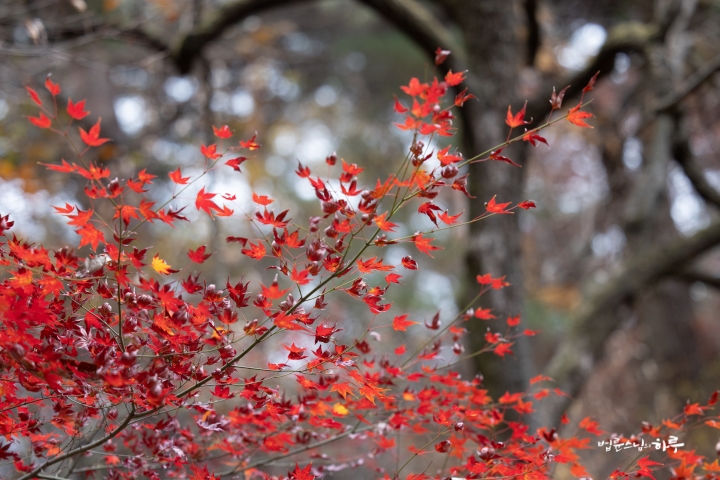
After completing his morning practice and meditation, Sunim attended to some work before heading to Gyeongju for the commemorative pilgrimage. In Seoul, about 30 religious leaders and social leaders boarded a bus at 8 AM to head to Gyeongju.
Sunim arrived in Gyeongju at noon to welcome the pilgrimage group.
“Welcome. I’m glad you’ve come to Gyeongju.”
“Thank you for inviting us.”
After exchanging warm greetings, they had lunch at a restaurant. After the meal, they headed to the birthplace of Suun Choe Je-u, the first destination of the pilgrimage. This is literally the place where Suun, who founded Cheondogyo, was born.

In front of the information board at the entrance of the birthplace, Park Nam-su, former head priest of Cheondogyo, explained about the birthplace of Choe Je-u. Despite having almost lost his voice due to a cold, the head priest passionately provided the explanation.

“This house burned down completely in the year Choe Je-u turned twenty. You might think, ‘If it burned down, why not just rebuild it?’ But when a fire occurs, what burns? Property burns, books burn. So all the Confucian history that his father, Geun-am Choe Ok, had been cultivating was burned away. This story also means that you shouldn’t practice with the history of Confucianism or Buddhism, but that you should realize something new on your own. So Suun left this place and wandered throughout the eight provinces. At that time, he vowed, ‘If I don’t obtain the way to save the people while traveling through the eight provinces, I will not return home.’
Many of you might misunderstand, wondering ‘What is Donghak and what is Cheondogyo?’ Most people probably think it was Donghak in the past and now it’s Cheondogyo. That’s not the case. It was Donghak in the past, and it’s still Donghak now. In a writing called Nonhangmun by Suun, it’s clearly recorded that ‘The Way is Cheondo (the Way of Heaven), and the Learning is Donghak (Eastern Learning).’ So Donghak is Cheondogyo, and Cheondogyo is Donghak. However, some people try to create conflict between Donghak and Cheondogyo, saying ‘We won’t do Cheondogyo! Instead, we’ll do Donghak,’ but Donghak is Cheondogyo, and Cheondogyo is Donghak.
Today is the Most Meaningful Day in the History of Religion in Korea
Today, we have Sunim here, as well as priests, pastors, and religious leaders. Today is the most meaningful day in the history of religion in Korea. It’s not just about the 200th anniversary of Suun’s birth, but the fact that social leaders and religious leaders from various faiths have gathered together for this pilgrimage is an incredible event. As far as I can remember, there has never been a time when religious leaders from all over Korea gathered in one place to celebrate the 200th anniversary of the birth of a religious founder. I want to express my sincere gratitude to all of you. Thank you very much.”
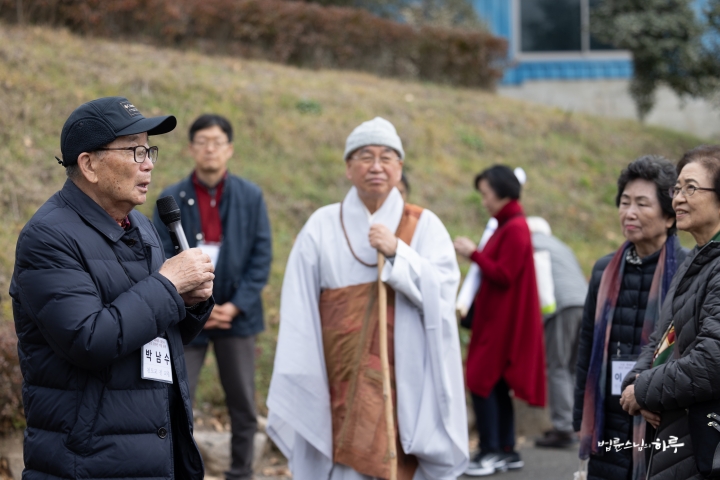

Everyone applauded, rejoicing in being part of this historic moment. Together, they entered the birthplace and took a tour around it.
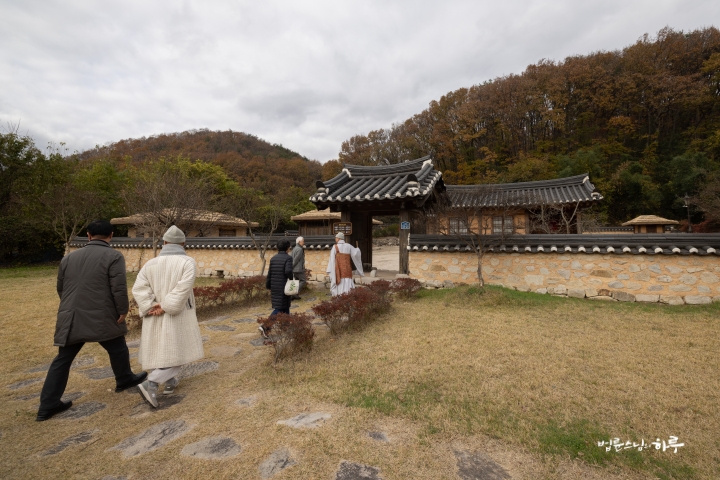

Former Head Priest Park Nam-su shared anecdotes related to Suun.

“After his great enlightenment, Suun first liberated his two female servants. He adopted one as his foster daughter and the other as his daughter-in-law.”
Upon hearing this, Lee Jung-ja, representative of Yeohae Women’s Forum, exclaimed in admiration.
“That was truly revolutionary for that time.”
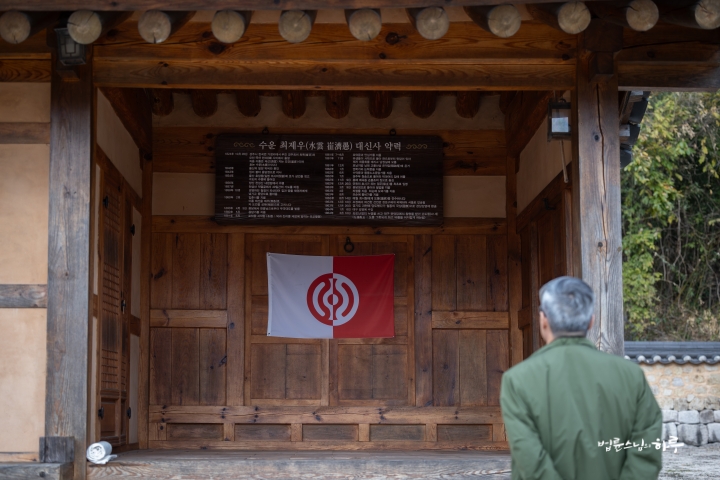


After touring the birthplace, everyone gathered for a commemorative photo. They captured this historic moment in a single photograph.

“Thank you, Suun!”
After shouting this together, they boarded the bus again and moved to the next location.

The next place they disembarked was the grave of Suun Choe Je-u. The grave was well-maintained at the foot of Gumisan Mountain, opposite his birthplace.


As they walked up the mountain path lined with autumn foliage, a cozy space appeared, surrounded by mountains on all sides with a high open sky. Until a few years ago, it was disappointing to see that the area wasn’t properly maintained, but recently the city of Gyeongju completed the grave maintenance project.

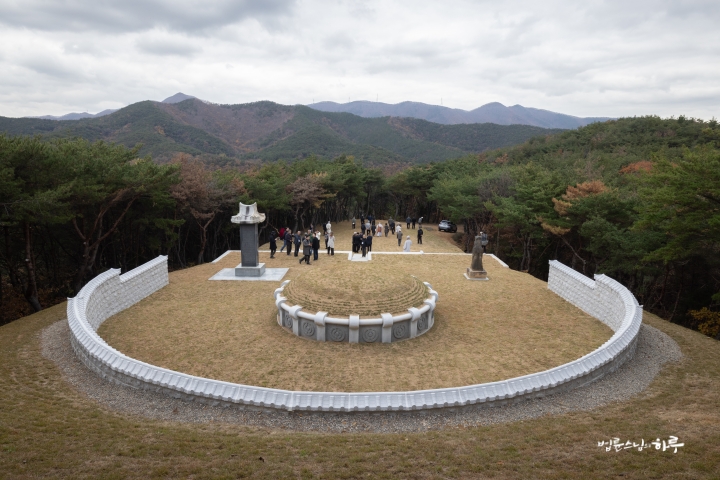
Once again, former Cheondogyo Head Priest Park Nam-su provided guidance about the grave.


“It’s natural that Suun’s grave is here on Gumisan Mountain. Suun was executed at Jangdae Gwandeokjeong in Daegu, but his body wasn’t removed for three days after his death. This was because there was still warmth in Suun’s body. Thinking that Suun might still be alive, they kept the body as it was, and on the seventh day, when his disciples touched him, they confirmed that he could no longer survive. Only then did they decide to move the body. At that time, since it was the body of a criminal accused of treason, they had to be very careful. So they decided to move the body to a place close to Daegu, and with Suun’s nephew, Choe Se-jo, who was living in this area, leading the way, they requested, ‘We would like to bury him in our mountain.’ That’s how this place within Yongdamjeong was confirmed as Suun’s grave. Even until the end of his tumultuous life, he suffered a lot, even in his burial.”
Following the head priest’s guidance, they held a memorial service at the grave site.
“Since this is where Suun rests, why don’t we all pay our respects with a moment of silence? Let us all pray!”

Sunim, pastors, priests, bishops, and religious leaders all took a moment to pray in front of the grave.

After a brief moment of silence, the head priest continued speaking.

“I’m truly grateful that all religious leaders of Korea have gathered here at Suun’s grave. Not only religious leaders but also social leaders have joined us, and I’m thankful for that. I believe Suun’s spirit must be very pleased.”
After the memorial service, they took time to look around the grave. The religious leaders who were part of the interfaith gathering – Sunim, priests, bishops, and religious officials – took a separate commemorative photo.

They descended the mountain path again and headed to Yongdamjeong, the birthplace of Donghak where Suun Choe Je-u attained enlightenment.
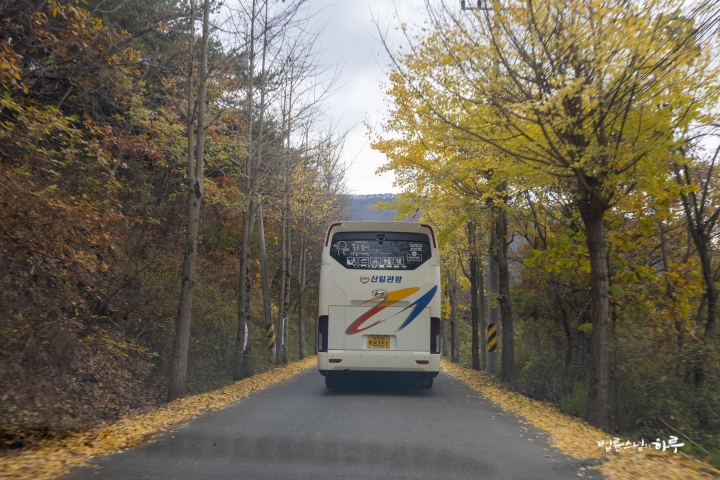
Yongdamjeong is located in the left valley of the mountain slope where the grave is. They got off the bus and walked up the mountain path again. From the entrance covered with yellow ginkgo leaves, the autumn foliage was at its peak.


The path leading up along the small valley on the left was also dyed with colorful autumn foliage, drawing admiration.


After passing through two gates at the entrance and climbing about 700 meters along the valley, the beautiful Yongdamjeong appeared.
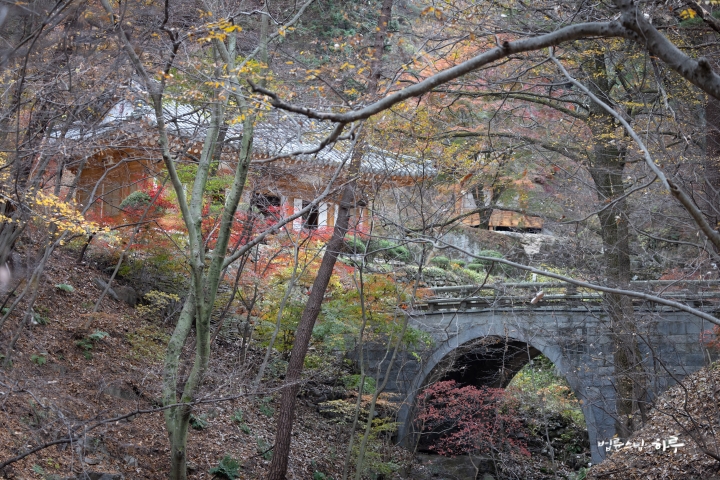

Once all participants were seated inside Yongdamjeong, the director of the Donghak Training Center began the Cheongsu Bongjeon, a prayer ritual of Cheondogyo. Cheongsu Bongjeon means to hold a unity ceremony, as Suun offered clear water when he was martyred. In Cheondogyo, they always pray with clear water.


“Attend to the Lord of Heaven, Determine Creation, Never Forget for All Eternity, Know All Things (侍天主 造化定 永世不忘 萬事知)”
After the Cheongsu Bongjeon, former Cheondogyo Head Priest Park Nam-su explained about Yongdamjeong.

“This Yongdamjeong is where Suun received the Muguk Daedo (Supreme Way) from Hanulnim (the Lord of Heaven) on April 5, 1860. Suun left this place at the age of twenty, saying he wouldn’t return to Yongdamjeong while traveling through the eight provinces, but after experiencing the mysterious ‘Eulmyo Cheonse,’ he felt he could no longer stay outside and returned to Yongdamjeong. The first thing he did upon returning to Yongdamjeong was to vow not to leave the mountain until he attained enlightenment. He then devoted himself wholeheartedly to studying to realize the Muguk Daedo of the Later Heaven’s 50,000 years. This continued until April 4, 1860, the first year of his propagation, and the next day he received a revelation from Hanulnim and attained enlightenment. That day was when Suun had his first religious experience. Yongdamjeong is the sacred place where the Muguk Daedo of the Later Heaven’s 50,000 years was founded. I think the reason we visit this place is to strengthen our belief in how we can directly experience and practice Suun’s teachings.”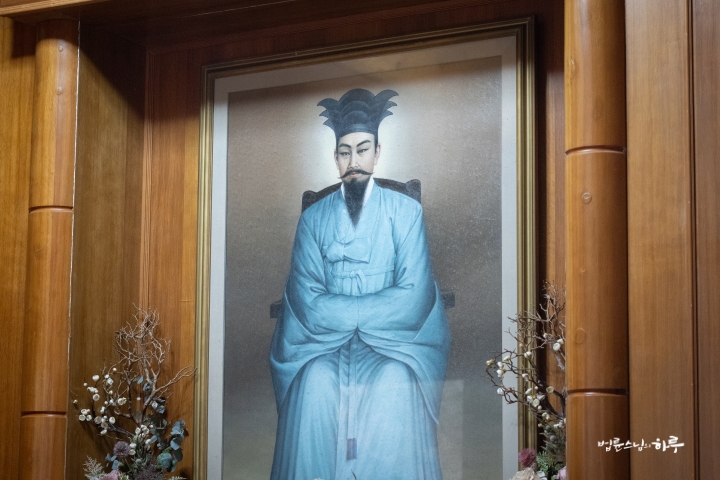

Everyone gathered in front of Yongdamjeong to take a commemorative photo and look around. The moss on the rocks added to the mystical atmosphere.
Climbing the stairs above Yongdamjeong, there was Yongchugak. Autumn had gently settled in everywhere. The maple leaves, shaped like a baby’s tiny hands, were particularly red.


After descending from Yongdamjeong, Sunim visited the Suun Memorial Hall. The life story of Great Master Suun Choe Je-u and the development process of Donghak were displayed in detail with various photographic materials and texts.

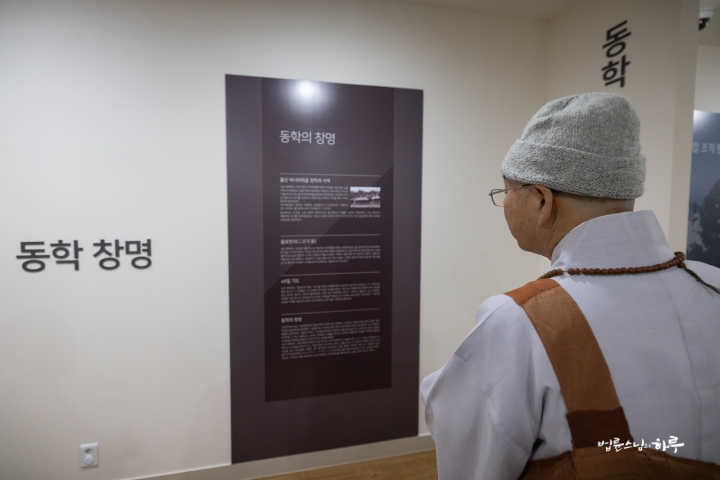
From 4 PM, a dialogue session was held in the main auditorium of the Donghak Education Center. Under the theme “The Birth, Background, Ascetic Practice, and Enlightenment of Great Master Suun Choe Je-u,” religious leaders and scholars gathered to explore the depth of Donghak and discuss the meaning of its teachings today.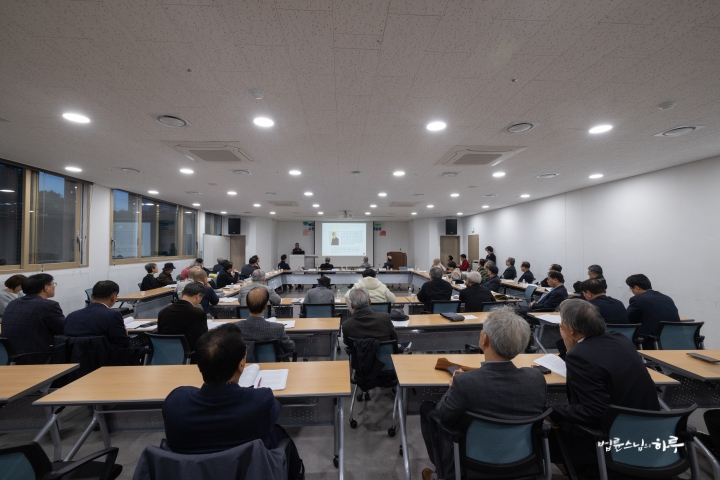
The dialogue began with Father Kim Hong-jin of the Catholic Archdiocese of Seoul as the moderator.
“I am happy and honored to be part of this meaningful pilgrimage. First, Venerable Pomnyun Sunim will introduce the guests in attendance.”
Sunim first explained the purpose of organizing this pilgrimage and opened the dialogue wide.
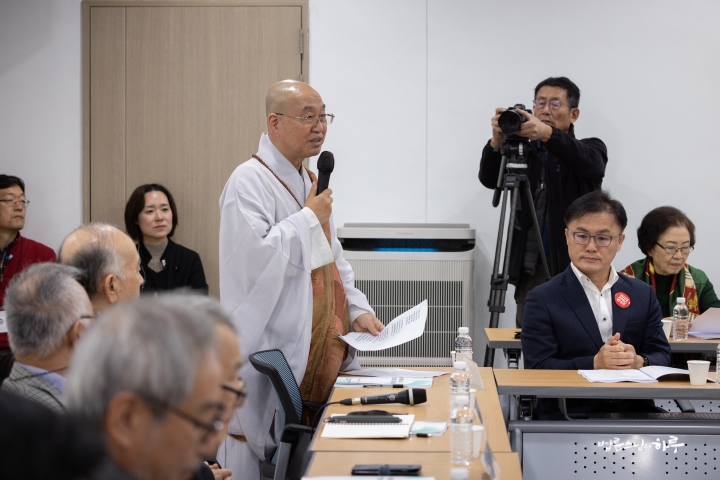
“This pilgrimage was organized by gathering the intentions of the Religious Group for National Reconciliation and Peace. In fact, this should have been an event organized by the state, but since the current government is not doing this, we decided to hold a modest event. We couldn’t do it for the 100th anniversary because it was during the Japanese colonial period, but for the 200th anniversary, given the current situation of the Republic of Korea, it should be done grandly. We thought we couldn’t just let it pass. Of course, Cheondogyo held a commemorative event, but we wanted to make it a bit more meaningful, so this gathering was arranged. Since Great Master Suun Choe Je-u is an important figure in our national history, we thought it was necessary to participate together regardless of religion, so all religious people participated.”
Sunim introduced all the guests in attendance. Representatives from Cheondogyo, the Anglican Church, Protestant churches, Won Buddhism, Catholicism, Buddhism, social elders, civic group activists, politicians, and research fellows and planning committee members from the Peace Foundation were present, encompassing various sectors of society. Many people active in the city council, cultural circles, historical circles, religious circles, media, and civil society in Gyeongju were also present as audience members. Loud applause erupted each time a name was called.
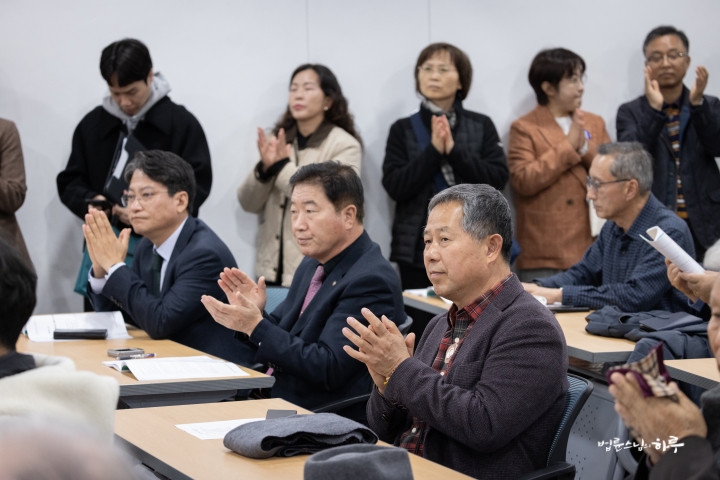
Then, the main dialogue began with greetings from Bishop Park Kyung-jo of the Anglican Church of Korea. The bishop stood up, smiled, and said:
“I have revered Jesus as my teacher all my life. However, after encountering the teachings of Cheondogyo, I thought that if I hadn’t been a Christian, I might have become a Cheondogyo believer. The thoughts of Great Master Suun resonated deeply with me and made me reflect on the religion I belong to.
Christianity spread by leading armies to occupy lands and planting crosses. I felt very ashamed when I saw such history of the church. That’s not what Jesus originally taught. However, Great Master Suun awakened the dignity of the people of this land. This is also why we need to gather the wisdom of the religions we believe in today. I think I should dedicate myself to renewing Christianity, which I belong to, by deeply engraving the teachings of Great Master Suun.”
The bishop’s remarks deeply moved the participants.
Next, the deputy mayor of Gyeongju gave a congratulatory speech on behalf of Mayor Joo Nak-young, who was delayed in returning from abroad. Welcoming the participants on behalf of Gyeongju citizens, he introduced major projects of Gyeongju City, including the restoration of Suun’s birthplace, the construction of the Donghak Education Center, and the restoration of Haewol Choe Si-hyeong’s birthplace, promising to continue dedicating efforts to enhance national pride.
The Revolutionary Meaning of Sicheonju (侍天主)
Two presenters were invited to kick off the dialogue session. First, Yoon Seok-san, the spiritual leader of Cheondogyo, introduced in detail the religious experience of Great Master Suun Choe Je-u and the process of founding Donghak. In particular, he explained the essence of the ‘Sicheonju (侍天主)’ ideology and emphasized the revolutionary nature of Donghak, which awakened the subjectivity of the people through it.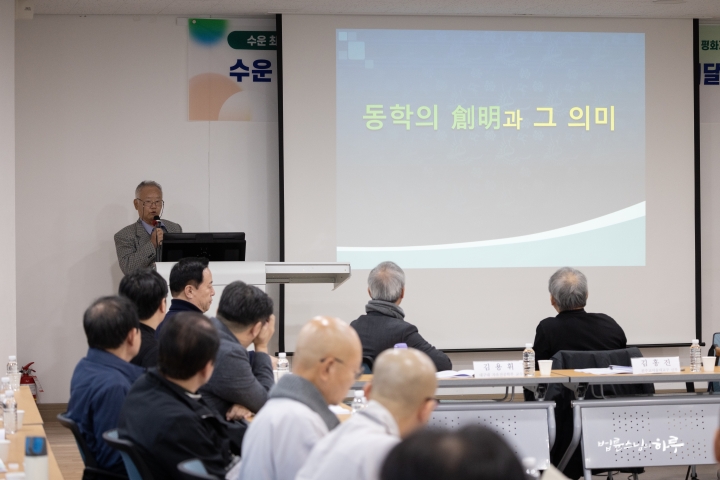

“The Way of Heaven existed before Suun Choe Je-u, but he was the one who first illuminated it, hence the term ‘Changmyeong (創明)’ is used. Sicheonju (侍天主) means serving the Lord of Heaven. The Lord of Heaven is not somewhere in a transcendent space, but fills the universe and is enshrined within me as a spirit. It was viewed that as beings serving the Lord of Heaven, kings and commoners were fundamentally equal. This was a revolutionary teaching that transcended the limitations of the feudal society at the time. The teaching of Sicheonju taught the realization that even the lower class should stand as subjects to overcome the crisis of this era, beyond the ruling and ruled classes. Without Suun Choe Je-u’s journey of seeking the Way and religious experience, the teaching of Donghak could not have existed in this world. The term ‘Hucheon Gaebyeok’ means achieving a life of harmony and balance through a new order, making everyone realize that they are sacred beings doing the work of the Lord of Heaven beyond social status. Realizing that I am a being serving the Lord of Heaven is realizing that I am a being who can lead a new history as a subject of this era. The founding of Donghak was an important historical event that paved the way for modernization and democracy indigenously before being influenced by the West.”
The spiritual leader emphasized that Great Master Suun’s enlightenment was not a mere religious experience, but a philosophical achievement obtained after thorough training and contemplation.
Donghak, the Seed of Korean Democracy
Next, Professor Kim Yong-hwi of Daegu University re-examined the significance of Donghak from a philosophical perspective. He emphasized that Donghak thought was the seed of Korean democracy, leading from the March 1st Movement to the April 19 Revolution and the Candlelight Revolution.


“The Donghak Peasant Revolution led to the March 1st Movement, which was succeeded by the Gwangju Student Independence Movement 10 years later, and after liberation, it continued to the April 19 Revolution, May 18 Democratization Movement, June Democratic Uprising, and the 2016 Candlelight Revolution. This is the manifestation of the Donghak spirit where the people correct wrongful power.
Donghak is not simply a study in response to Western learning, but means ‘the learning of the Eastern country’. It was a new learning for the people of Joseon and a philosophical attempt to restore the essence of humans and the universe. Master Suun tried to re-illuminate the Way of Heaven (天道) that had been lost for 2,000 years in the land of Joseon, and to save the people in distress through the restoration of the Way and virtue. Sicheonju means not only realizing the immanence of God within oneself but also fully embodying the nature of heaven and achieving self-realization. The ‘Later Heaven Opening’ mentioned by Master Suun signifies a civilizational transformation, presenting a new life that respects all beings, empathizes with suffering, and practices sharing through an inner revolution. Donghak presented a new civilization beyond Western modern civilization and Eastern Confucian civilization, and was a civilization transformation movement that integrated East and West.
Our task today is to inherit the spirit of Donghak to overcome the ecological crisis and human spiritual crisis, and to open a new civilization of dignity and morality. Donghak emphasizes opening a new era through a life that respects all beings by declaring human dignity and equality. Donghak is not just a religion, but a study and practical philosophy that presents how to understand the universe, life, and humans, and how to act.”

The professor evaluated that Donghak presented a new civilization combining the wisdom of the East and West, rather than being a concept opposed to Western learning.
After the two presentations, the discussion began in earnest. Donghak thought was discussed from various perspectives. In particular, Father Kim Ki-hwa’s remarks left a deep impression. Father Kim suggested the essence of Donghak and the direction it should take in the future.

“Master Choe Je-u experienced and accepted the special love of Hanulnim. However, if we stop at idolizing him, Donghak cannot move forward. For Donghak to advance, hundreds of thousands of people who have attained the same enlightenment as Master Choe Je-u must emerge. That is the true teaching of Master Choe Je-u. Donghak is a movement that moves forward through individual enlightenment and practice. Donghak that only praises Master Choe Je-u will eventually collapse.”
In response, the presenters emphasized that Donghak sought to transform individuals and society in harmony between Hanulnim and humans, embracing Father Kim’s perspective and expanding the discussion.
At the end of the event, Lee Cheol-woo, the Governor of North Gyeongsang Province, was present to express his gratitude and encourage the efforts of the pilgrimage group and the organizers. He emphasized that he would take the lead in peace on the Korean Peninsula by inheriting the spirit of Great Master Choe Je-u.

“North Gyeongsang Province takes pride in inheriting the spirit of Master Suun Choe Je-u as the birthplace of Donghak. We will continue to promote the value of Donghak to the world and strive for lasting peace on the Korean Peninsula. Next year, the APEC Summit will be held in Gyeongju. APEC is a meeting of economic leaders from the Asia-Pacific region, and as Gyeongju is a land full of the spirit of national unification, I hope this event will be an opportunity for world peace and prosperity. President Putin, President Trump, and President Xi Jinping are expected to participate. If inter-Korean relations improve, we hope that meaningful peace discussions like the Six-Party Talks can take place in Gyeongju by inviting Chairman Kim Jong-un as well. Please pray and work together so that this APEC can be an important event that opens the path to peace and prosperity, receiving the energy of inter-Korean unification.”

The dialogue session ended at 6 PM. A commemorative photo was taken, engraving the thoughts of Great Master Suun Choe Je-u in their hearts.

Sunim continued the conversation over tea with Lee Cheol-woo, the Governor of North Gyeongsang Province. The governor spoke more specifically about the importance of the APEC Summit to be held in Gyeongju and the vision of inter-Korean peace and international cooperation through it, and also listened to Sunim’s advice.
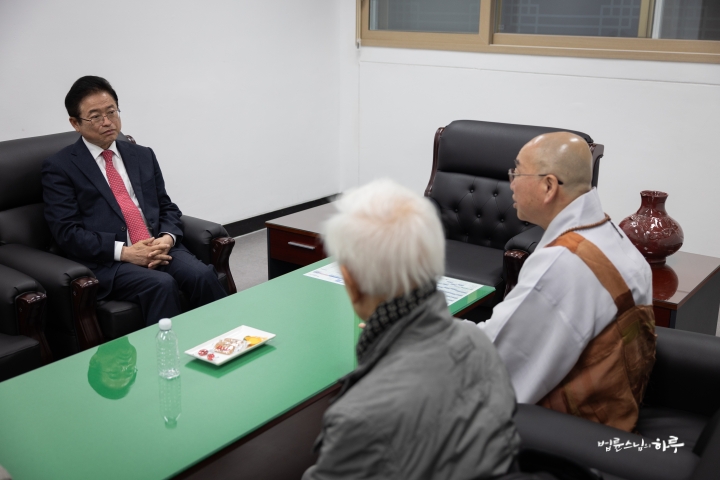
After the tea talk, all participants had a buffet dinner and continued their unfinished conversations. After dinner, Sunim asked for the participants’ understanding.
“I have a lecture in Pohang this evening. I will rejoin you again tomorrow morning.”
Sunim departed for Pohang to give his lecture, while the participants had a time to know each other starting at 7 PM.
Sitting in a circle, each person introduced themselves and shared their thoughts on the day’s pilgrimage through Choe Je-u’s birth, growth, and enlightenment. The first day in Gyeongju concluded with deep resonance and enlightenment.
Today’s lecture is held at the Pohang Baetmeori Lifelong Education Center. This is the first offline Dharma Q&A lecture in Pohang in five years since the COVID-19 pandemic. It’s the twelfth “Happy Dialogue” lecture this year.

The lecture began with a pre-performance in front of 350 Pohang citizens who filled the venue. Choi Su-bi, a busking performer, sang two exciting songs. On YouTube, about 4,900 people connected to the live broadcast.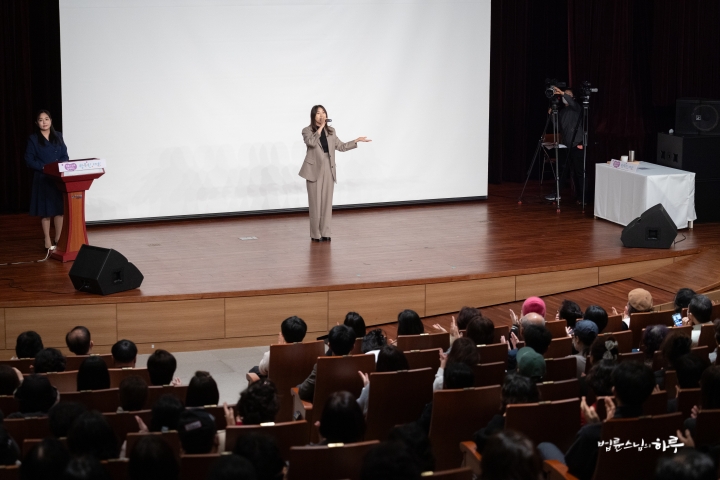

Next, after watching a video of Sunim’s recent visit to the Turkey-Syria border region where he built and inaugurated a new school for earthquake recovery, Sunim took the stage.
As the applause subsided, Sunim greeted the audience with a bright smile.
“Dharma talk is not just about discussing Buddhist doctrines. If we can share our daily struggles and alleviate that suffering, that too can be called a Dharma talk. This is a place to discuss your doubts or stresses. While it may seem like a one-on-one conversation with me, all 350 people here are participating together, nodding or shaking their heads, creating a collective Dharma discussion. Even if someone talks about marital conflicts or issues with children, don’t think, ‘That family has problems’ or ‘They’re having a marital dispute.’ The question is just a topic for the Dharma talk. Through these questions, we can gain insights on how to live our lives. Now, let’s hear your stories.”
Following this, five pre-registered individuals had conversations with Sunim, after which impromptu questions were taken from the audience. Over two hours, eight people asked Sunim questions. One of them asked about the dilemma of being afraid to live alone in old age but also feeling burdened about relying on her daughters.
I’m Scared to Live Alone, but I Also Feel Burdened Relying on My Daughters
“What’s so difficult about dreaming? Everyone here has such dreams. They just don’t talk about it.”
“It’s very scary.”
“You lock your door when you sleep, so what’s there to be afraid of?”
“I haven’t done anything wrong, but having these scary dreams is very distressing.”
“So you have done something wrong.”
“No, I haven’t.”
“If you haven’t done anything wrong, why are you afraid?”
“I’ve had many surgeries, and I feel sorry that my children had to pay for them, which must have been very difficult for them.”
“You can worry that it might be hard for your children, but from their perspective, would they prefer you to worry and feel distressed about it? Or would they prefer you to be at peace, even if they have to pay for hospital bills and take care of you?”
“I think they’d prefer me to be at peace.”
“Then why are you making your children uncomfortable? Aren’t you actually causing them more distress? Your children are okay with taking you to the hospital and paying the bills, and they want you to receive treatment comfortably. But if you feel sorry and distressed about burdening them, doesn’t that negate their efforts to help you?”
“My children always tell me not to worry about money.”
“Since you’re receiving help from your children, shouldn’t you listen to them a bit?”
“I try to, but my heart doesn’t feel that way. I feel sorry for making things so difficult for my children.”
“So are you saying you want to die now?”
“No, that’s not it. The problem is that I have too many dreams when I sleep at night.”
“Then why don’t you live with your daughter? Wouldn’t it be better if you lived together in adjacent rooms?”
“My daughter works, and I’m worried it might be hard for her if we live together.”
“Since your daughter works, you could live together, do the housework during the day, and sleep in the next room at night. You’re afraid at night when you sleep, right? What’s the problem with sleeping in the same house at night and her going to work during the day? Is this your youngest daughter? Is she not married yet?”
“No. not yet”
“Then you can live together. If living in the same house is burdensome, you could get two small apartments close to each other and live separately.”
“Yes, we’re living separately now.”
“If your daughter lives nearby in the next building, wouldn’t you feel less anxious psychologically?”
“My daughter says that too, but I can’t feel at ease.”
“Then you shouldn’t burden your daughter.”
“I try not to burden her, so I don’t tell her when I’m sick unless it’s really serious.”
“You say you can’t speak, but you’re saying everything. Think about it again. If your daughter said she couldn’t help you anymore because she doesn’t have money or can’t take care of you anymore, that would be unavoidable. But your daughter is telling you not to worry about money and to receive treatment comfortably, right? Then the way to repay your daughter is to be at ease. If you receive help from your daughter but can’t be at ease like now, it negates her efforts to help you financially and care for you. Then you become the bad person. If you understand this, you should pull yourself together.”
“I try to think that way, but it doesn’t work out as I intend.”
“Then you need to visit the doctor and receive psychiatric treatment. When do you think your daughter feels most rewarded for paying your hospital bills and taking care of you? She feels rewarded when you’re at ease. But if you’re anxious even after she’s done all that for you, doesn’t it negate her efforts to make you comfortable? You’re anxious, so she suggests living together to make you more comfortable, but you refuse that too. Then you shouldn’t tell her about your scary dreams and how frightened you are in front of her. You’re telling her about your scary dreams, making her very worried, but you’re not doing what she suggests.”
“It’s to avoid burdening her.”
“You say it’s to avoid burdening her, but you’re continuously burdening your daughter. Stop talking nonsense. (Laughs) If you don’t want to burden her, you shouldn’t mention having bad dreams and being scared. You should manage well on your own. Or you could find a companion to stay with you, which might make you less scared.”
“I don’t like that idea.”
“You don’t like this, you don’t like that, what exactly do you want to do?”
“I just want to live without being a burden to my daughter.”
“How about entering a nursing home?”
“I don’t like that either.”
“Then do as you please. You don’t like this, you don’t like that, this is burdensome, that is burdensome, but in the end, you want to do what you want. What exactly are you trying to do? Since you’re going to do what you want anyway, you’ll have to live with being scared when you’re scared and lonely when you’re lonely. There’s no other way. Should I give you a prayer that prevents dreams?”
“Yes.”
“It’s because of people like you that those who sell prayer formulas for money come into existence. People like you are prone to being scammed by religious organizations. Stop thinking unnecessarily. If you’re in a situation where you have to rely on your daughter, ask her, ‘Mom is sorry, but I’m in a situation where I have no choice but to rely on you. Would it be too much of a burden for you?’ If your daughter says it’s burdensome, then you’ll have to live alone even if you’re scared. But if she says it’s okay and she wants to live with you, then live together. However, given your personality, there’s a high chance that problems will arise even if you live together. You’re a person who has problems no matter what. In that case, you have no choice but to try living this way and that way. There’s no other way. First, try living with your daughter, and if problems arise in your relationship, try living separately again. You need to look at yourself while going through these trial and error processes. You’re someone who finds problems with one thing when you try to do another, and dislikes one thing when you try to do something else. You need to realize that it’s ultimately your problem. Do you go to a Catholic church?”
“No, I go to a Buddhist temple.”
“I think it would be good if you went to a Catholic church for a while.”
“Actually, someone recently suggested that I should go to church.”
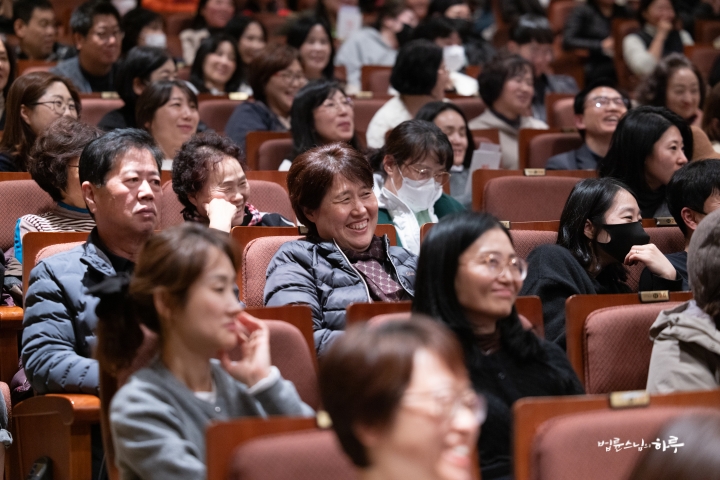
“If there are any Catholics here, please take this person to church. Go to a Catholic church and beat your chest three times a day saying, ‘It’s my fault. It’s my fault. It’s my fault.’ You need to look at yourself correctly. That might help you.If there’s always a problem no matter what you do, you need to realize that you yourself are the problem. In such cases, you can try doing things one way and then another way.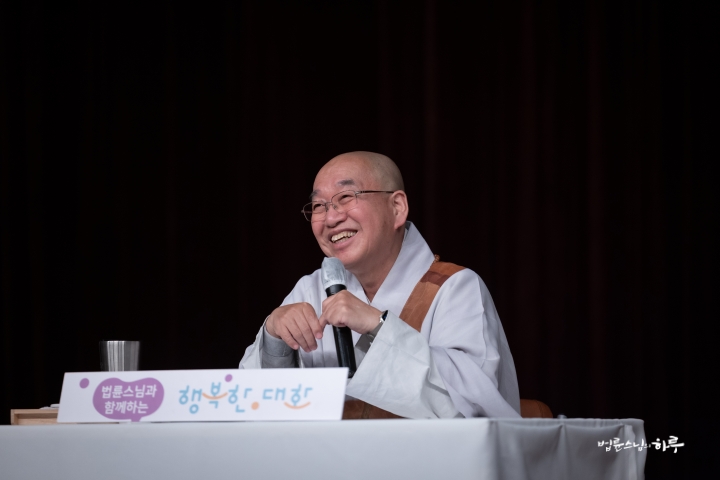
Long ago, an old woman complained to a monk that she worried whether it rained or shined. When the monk asked why, she explained that her eldest daughter had married a straw shoe merchant, while her younger daughter had married a wooden clog merchant. On rainy days, she cried worrying about her eldest daughter because straw shoes wouldn’t sell, and on sunny days, she cried worrying about her younger daughter because wooden clogs wouldn’t sell. The monk advised her, “On rainy days, think only of your daughter selling wooden clogs, and on sunny days, think only of your daughter selling straw shoes.” This shows how the same situation can change just by shifting one’s perspective.
However, you always try to hold onto what you want and not let go. If you just change your thinking, it’s not a problem at all. If you keep clinging to one thing, it becomes difficult, but if you change your mindset to be content either way, there’s no problem. If you try living with this perspective, you can live much more freely.”
“Thank you.”

The questions continued. After taking three more questions from the audience, it was 9:30 PM.

Immediately after the lecture, Sunim held a book signing session on stage. Many citizens lined up to greet him and express their gratitude.

“Thanks to you, Sunim, I’ve become much happier. Thank you.”
After the book signing, Sunim took a commemorative photo with the volunteers who prepared the lecture.
“Happy citizens, Pohang!”
Sunim expressed his gratitude to the volunteers. Leaving the lecture hall, he immediately departed from Pohang and headed to Dubuk Jungto Retreat Center.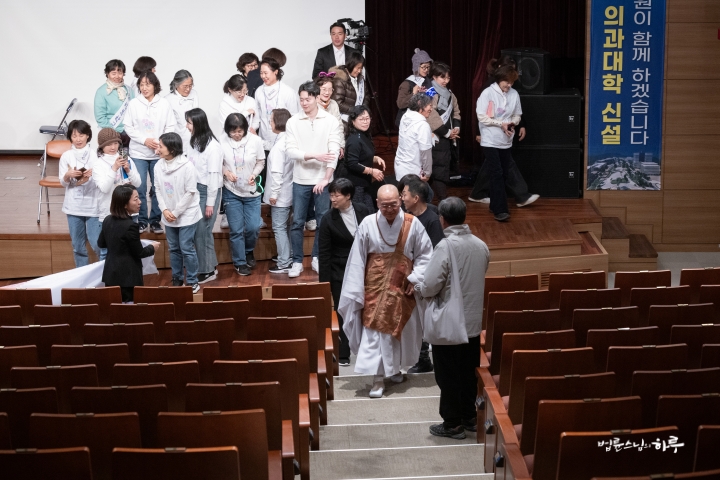
After an hour’s drive, Sunim arrived at Dubuk Retreat Center at 11 PM and concluded his daily routine.
Tomorrow is the second day of the pilgrimage commemorating the 200th anniversary of the birth of Suun Choi Je-u. Following in the footsteps of the Great Master, Sunim will depart from Gyeongju and move to Namwon, visiting Deokmil-am in Gyoryongsan Fortress where many Donghak scriptures, including Donggyeong Daejeon, were written. In the afternoon, he will continue the dialogue session with Namwon city officials and Donghak researchers.




